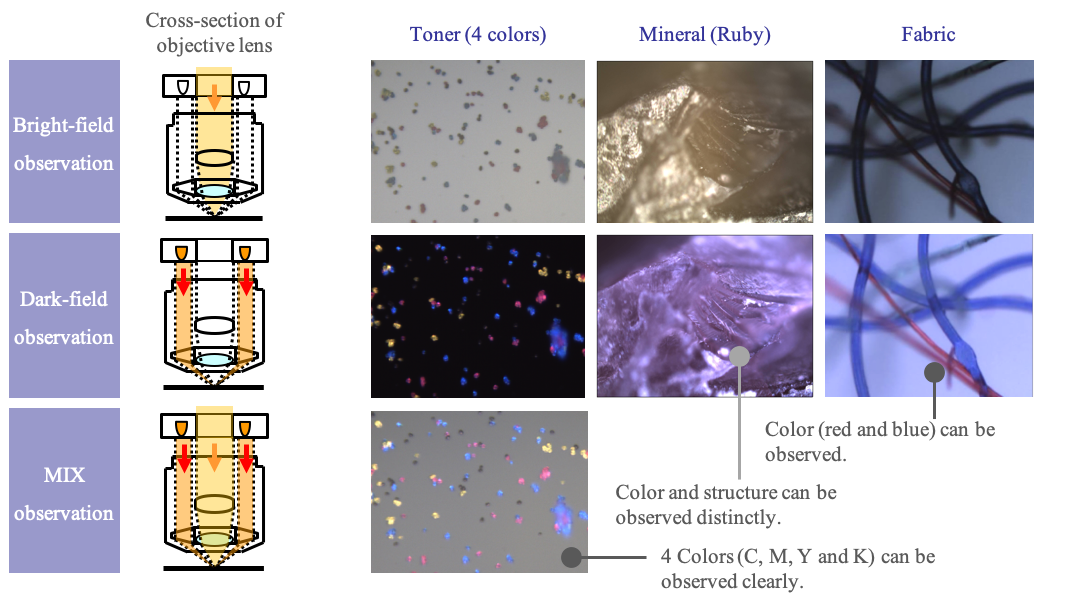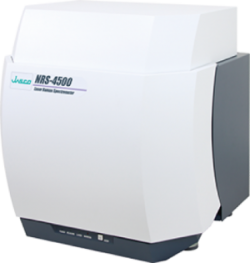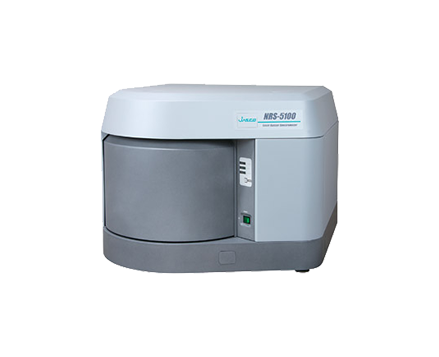Observation and Measurement examples using Dark-field and MIX observation
January 5, 2024
Introduction
In Raman microscopy, the quality of sample observation is essential for identifying suitable measurement points. The NRS Series of Raman spectrometers can be used with various types of observation: Bright-field (epi-illumination), Bright-field (transmitted illumination), Dark-field, MIX, Polarized and Differential Interference.
This application note introduces two of these methods: Dark-field and MIX observation, which are recommended for observation of colored and heterogeneous samples.
What is Dark-field observation?
Bright-field observation is most common, and uses light irradiated from the center of the objective lens, and the reflected light is collected. Dark-field observation differs in that the light is irradiated from outside of the objective lens by using ring-illumination, and the scattered light and diffracted light are collected. This results in observation of the scattered and diffracted light reflected from the sample in a dark field of view.
Advantage #1 Observation of colored sample
In Dark-field observation, the color (except for black) of the sample can be observed clearly. Since the background will become dark, black samples can be difficult to observe.
Advantage #2 Observation of heterogeneous sample
Dark-field observation is very effective for observing heterogeneous samples (several 10 nm). Although Differential Interference observation is often used for this type of sample (several nm), its observation filter has to be removed when performing the measurement, because of the difference between the optical path for observation and that for Raman measurement. On the other hand, Dark-field observation enables Raman measurement with the same objective lens without changing filters.
What is MIX observation?
MIX observation is the attractive technique combining both “Bright-field” and “Dark-field” observation, and offers excellent observation of images by utilizing the unique advantages of both methods. Especially, MIX mode observation can be used to observe black samples, which the Dark-field observation is not well suited to.

Experimental
Dark-field and MIX observation are performed using a dedicated objective lens with LED illumination arranged in a ring*. Since the objective lens and the illumination can be mounted/dismounted easily, other observation methods such as the Bright-field can be easily exchanged. In addition, the direction of illumination for Dark-field observation can be changed, and the target in the observed image can be selectively emphasized.
* Dark-field and MIX observation only work with a dedicated objective revolver (factory option only).

Observation and measurement example: Multivitamin
An NRS-4500 Raman spectrometer (Figure 2) was used for this measurement, and particles in a vitamin capsule were observed using Dark-field and MIX modes. Using Dark-field mode the white and yellow particles could be clearly identified against a dark background, and in MIX mode the white and yellow particles could be clearly identified against a bright background (Figure 3). These particles were measured at appropriate excitation wavelengths (white: 532 nm, yellow: 785 nm), and a database search was performed on the obtained spectra. From the result of the database search, the white particles were identified as vitamin C, and yellow particles as vitamin B2. Identifying the color when observing the sample provides additional useful information about the components and their correlation with the obtained Raman spectra.

Observation image (left), Raman spectra and database search results (right)
Using Dark-field and MIX observation modes, it is possible to more clearly observe the color and surface heterogeneity such as sample color, surface scratches/defects, and shapes that were difficult to see with conventional observation methods. Enhancement of observation helps with better identification of the measurement point, and enables faster, more reliable measurement of spectral data. These observation modes are recommended for the following sample types.
– Color information on fabrics, particles, printing etc.
– Heterogeneous information on rocks and minerals, scratches on color panels etc.
| System Configuration | Model | Description | Part Number |
| Main Unit | NRS-4500-532 | Raman Spectrometer | 7118-J051A |
| Options | RMIX4 | MIX observation unit (Factory Option) | 7118-J255A |
| LMPLFLN20xBD | Objective lens, x20, for Dark-field (Vis range) | 1108-0134 | |
| 785 nm laser upgrade package (Factory Option) | 7118-J201A |
Keywords
260-AN-0020
Featured Products:

Observation and Measurement examples using Dark-field and MIX observation
Introduction
In Raman microscopy, the quality of sample observation is essential for identifying suitable measurement points. The NRS Series of Raman spectrometers can be used with various types of observation: Bright-field (epi-illumination), Bright-field (transmitted illumination), Dark-field, MIX, Polarized and Differential Interference.
This application note introduces two of these methods: Dark-field and MIX observation, which are recommended for observation of colored and heterogeneous samples.
What is Dark-field observation?
Bright-field observation is most common, and uses light irradiated from the center of the objective lens, and the reflected light is collected. Dark-field observation differs in that the light is irradiated from outside of the objective lens by using ring-illumination, and the scattered light and diffracted light are collected. This results in observation of the scattered and diffracted light reflected from the sample in a dark field of view.
Advantage #1 Observation of colored sample
In Dark-field observation, the color (except for black) of the sample can be observed clearly. Since the background will become dark, black samples can be difficult to observe.
Advantage #2 Observation of heterogeneous sample
Dark-field observation is very effective for observing heterogeneous samples (several 10 nm). Although Differential Interference observation is often used for this type of sample (several nm), its observation filter has to be removed when performing the measurement, because of the difference between the optical path for observation and that for Raman measurement. On the other hand, Dark-field observation enables Raman measurement with the same objective lens without changing filters.
What is MIX observation?
MIX observation is the attractive technique combining both “Bright-field” and “Dark-field” observation, and offers excellent observation of images by utilizing the unique advantages of both methods. Especially, MIX mode observation can be used to observe black samples, which the Dark-field observation is not well suited to.

Experimental
Dark-field and MIX observation are performed using a dedicated objective lens with LED illumination arranged in a ring*. Since the objective lens and the illumination can be mounted/dismounted easily, other observation methods such as the Bright-field can be easily exchanged. In addition, the direction of illumination for Dark-field observation can be changed, and the target in the observed image can be selectively emphasized.
* Dark-field and MIX observation only work with a dedicated objective revolver (factory option only).

Observation and measurement example: Multivitamin
An NRS-4500 Raman spectrometer (Figure 2) was used for this measurement, and particles in a vitamin capsule were observed using Dark-field and MIX modes. Using Dark-field mode the white and yellow particles could be clearly identified against a dark background, and in MIX mode the white and yellow particles could be clearly identified against a bright background (Figure 3). These particles were measured at appropriate excitation wavelengths (white: 532 nm, yellow: 785 nm), and a database search was performed on the obtained spectra. From the result of the database search, the white particles were identified as vitamin C, and yellow particles as vitamin B2. Identifying the color when observing the sample provides additional useful information about the components and their correlation with the obtained Raman spectra.

Observation image (left), Raman spectra and database search results (right)
Using Dark-field and MIX observation modes, it is possible to more clearly observe the color and surface heterogeneity such as sample color, surface scratches/defects, and shapes that were difficult to see with conventional observation methods. Enhancement of observation helps with better identification of the measurement point, and enables faster, more reliable measurement of spectral data. These observation modes are recommended for the following sample types.
– Color information on fabrics, particles, printing etc.
– Heterogeneous information on rocks and minerals, scratches on color panels etc.
| System Configuration | Model | Description | Part Number |
| Main Unit | NRS-4500-532 | Raman Spectrometer | 7118-J051A |
| Options | RMIX4 | MIX observation unit (Factory Option) | 7118-J255A |
| LMPLFLN20xBD | Objective lens, x20, for Dark-field (Vis range) | 1108-0134 | |
| 785 nm laser upgrade package (Factory Option) | 7118-J201A |
Keywords
260-AN-0020

 Download This Application
Download This Application
